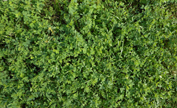This item has been supplied by a forage marketer and has not been edited, verified or endorsed by Hay & Forage Grower.

Northern N.Y. Alfalfa is an excellent source of protein in the dairy cow diet. Research funded by the farmer-driven Northern New York Agricultural Development Program (NNYADP) is evaluating new opportunities to grow alfalfa in combination with grass species to provide dairy farmers with the opportunity to enhance forage yield, quality, and digestibility. The results of the most recent alfalfa-grass mix trials conducted by Cornell University researchers are posted on the NNYADP website at www.nnyagdev.org.
The field trials, which continue in 2019, rank the alfalfa-grass varieties and mixes for factors that influence milk production. Those factors include fiber digestibility, crude protein, and lignin. Lignin is a fiber component of alfalfa that helps the plant grow upright, but at higher levels decreases the digestibility of that alfalfa in a dairy ration.
Early indications show that a combination of reduced-lignin alfalfa planted with the right meadow fescue can result in a large increase in forage digestibility, which in turn encourages proper daily dry matter feed intake by cows to support milk production.
The on-farm trials in Jefferson and Lewis counties are focused on meadow fescue varieties that are winter-hardy and add the opportunity for higher fiber digestibility.
"Our results continue to show that meadow fescue has great potential to significantly improve forage quality when planted with a high quality alfalfa. These regionalized trials are especially important for analyzing the localized conditions that impact grass yield and quality," said project leader Debbie J.R. Cherney, a Cornell University professor of Animal Science.
Cherney says climate naturally plays a key role in how each type of crop in the mix matures.
"Alfalfa growth in primarily controlled by heat units or growing degree days, while grass development in the spring is driven by day length. Depending on the conditions in any given year, one crop in the mix may mature at a normal rate, while the other can be significantly delayed," Cherney explained.
The varieties under evaluation in the Northern New York trials include those grown from meadow fescue seed developed in European environments that are cooler and with a shorter growing season than in Northern New York.
The research data indicates that while grass percentage in the mix can impact yield and the crude protein content of the grass, it does not significantly impact other forage quality measurements for the alfalfa or grass in the mix.
The next objective for the alfalfa-grass research team is to evaluate opportunities to achieve a consistent 20-30 percent, high quality grass mixture from year-to-year under variable growing conditions. The research plan in 2019 includes assessing the impact of different seeding rates for meadow fescue planted with reduced-lignin alfalfa and testing a large group of meadow fescue varieties, many of which have not yet been grown in North America.
Funding for the Northern New York Agricultural Development Program is supported by the New York State Legislature and administered by the New York State Department of Agriculture and Markets.
MEDIA CONTACTS:
- Project leader Debbie J.R. Cherney, Cornell University, 607-255-2882
- NNYADP Co-Chairs: Jon Greenwood, 315-386-3231; Joe Giroux, 518-563-7523; Jon Rulfs, 518-572-1960
- NNYADP Coordinator: Michele Ledoux, 315-376-5270, mel14@cornell.edu
- Publicist Kara Lynn Dunn, 315-465-7578, karalynn@gisco.net

